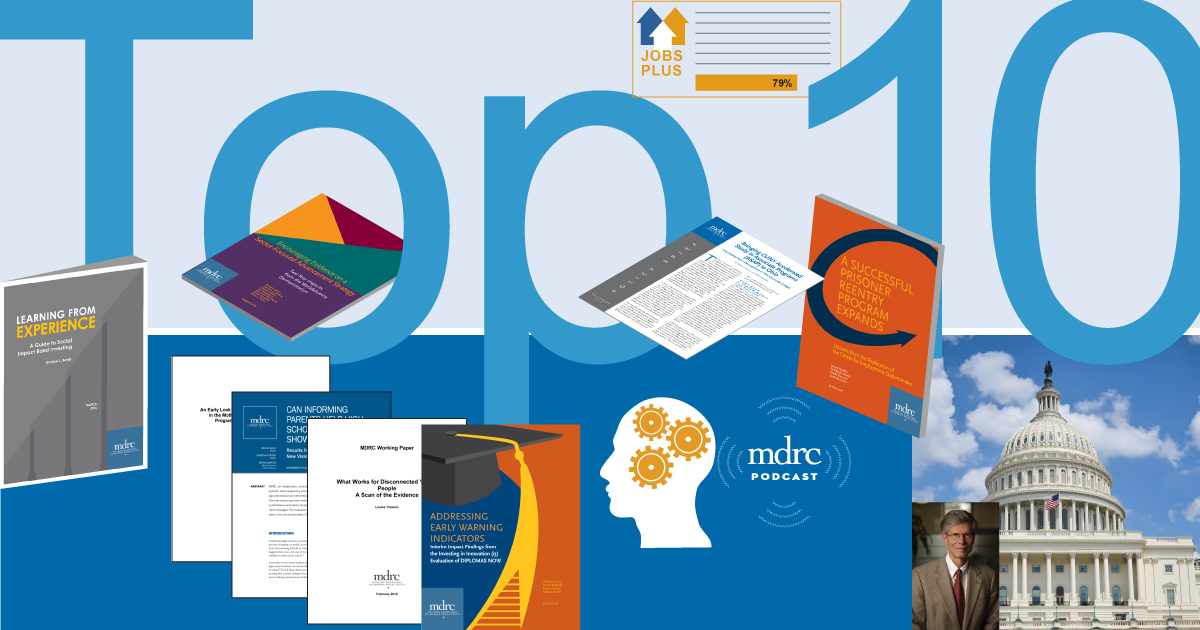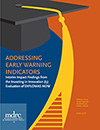Top 10 MDRC Publications from 2016 (Plus the Top Infographic, Podcast, and Video!)

In 2016, MDRC has published more than 50 reports and briefs on programs affecting low-income Americans in all realms of education and social policy: education from preschool to postsecondary, workforce development, behavioral science, youth development, home visiting, and more. Here’s a list of 10 of our most popular publications released in 2016 — plus the top infographic, video, and podcast!
TOP 10 PUBLICATIONS
WorkAdvance provides demand-driven skills training and a focus on jobs with career pathways. As detailed in this full report, all four programs studied greatly increased training completion and credential acquisition. Employment outcomes varied by site, with large, consistent impacts at the most experienced provider and promising results at two others.
 Learning from Experience: A Guide to Social Impact Bond Investing
Learning from Experience: A Guide to Social Impact Bond Investing
MDRC President Gordon Berlin draws lessons from MDRC’s implementation of the first social impact bond (SIB) project in the United States, providing valuable insights into the inner workings of SIB deals and explaining the challenges and the potential of this impact investing model.
What Works for Disconnected Young People: A Scan of the Evidence
Disconnected young people are the focus of several recent national initiatives to improve their life prospects. Drawing on interviews and available research, this MDRC Working Paper scans the current state of policy and evidence regarding what works in helping young people reconnect to work or school.
An earlier MDRC evaluation found that the original Center for Employment Opportunities transitional jobs program reduced the rates at which important subgroups of participants committed new crimes or were reincarcerated. The current evaluation finds that five new replication programs have implemented the model faithfully.
The Diplomas Now whole-school reform model, including targeted interventions for students at risk of dropping out, had an impact on the percentage of students with no early warning indicators related to attendance, behavior, or course performance, and had more encouraging results in middle schools than high schools.
Using Financial Aid to Speed Degree Completion: A Look at MDRC’s Research
How can financial aid be used to improve academic success for low-income college students? Evidence suggests that providing additional financial support to increase students’ enrollment intensity — either increasing the number of credits they take each semester or enrolling in courses during the summer — can boost credit accumulation and may help them complete degrees faster.
CUNY ASAP has proved exceptionally effective at increasing community college graduation rates. This demonstration tests the viability and effects of programs modeled on ASAP in different types of colleges, including those serving many nontraditional students. Early findings show increases in full-time enrollment, credits earned, and persistence into the second semester.
In testimony before the Senate Finance Committee, MDRC President Gordon Berlin provides a brief history of the federal government’s bipartisan investment in evidence building and offers thoughts on next steps for making evidence, including pay-for-success initiatives, a driver of policy change.
A custom-designed intervention aimed to improve New York City high school students’ attendance by using text messaging to send parents daily absence updates and weekly attendance summaries. The rapid-turnaround randomized evaluation found that the short-term intervention did not improve attendance rates during the second semester of the 2015-2016 school year.
MIHOPE-Strong Start is the largest random assignment study to date examining the effects of home visiting services on birth and health outcomes and health care use. This report describes a partial sample of 1,200 families, explores the priorities and practices of the study programs, and discusses program recruitment.
TOP INFOGRAPHIC, PODCAST, AND VIDEO
Jobs-Plus – a “place-based,” workforce-development model proven to help public housing residents find employment – is about to be replicated across the country. This infographics depicts the program model, its effects on earnings, and the history of its development over the past 20 years.
 Podcast: Using “Nudges” to Improve Social Programs
Podcast: Using “Nudges” to Improve Social Programs
Can small changes based on the insights of behavioral science improve the effectiveness of social programs? Join Therese Leung as she talks to three guests about MDRC’s work in behavioral science, with a particular focus on improving child support programs.
 Video: Paycheck Plus: Making Work Pay for Low-Income Workers
Video: Paycheck Plus: Making Work Pay for Low-Income Workers
This eight-minute video profiles the lives of six New Yorkers who are participating in the Paycheck Plus demonstration of an enhanced Earned Income Tax Credit for workers without dependent children. It also explains what MDRC hopes to learn from a random assignment study of the initiative.












